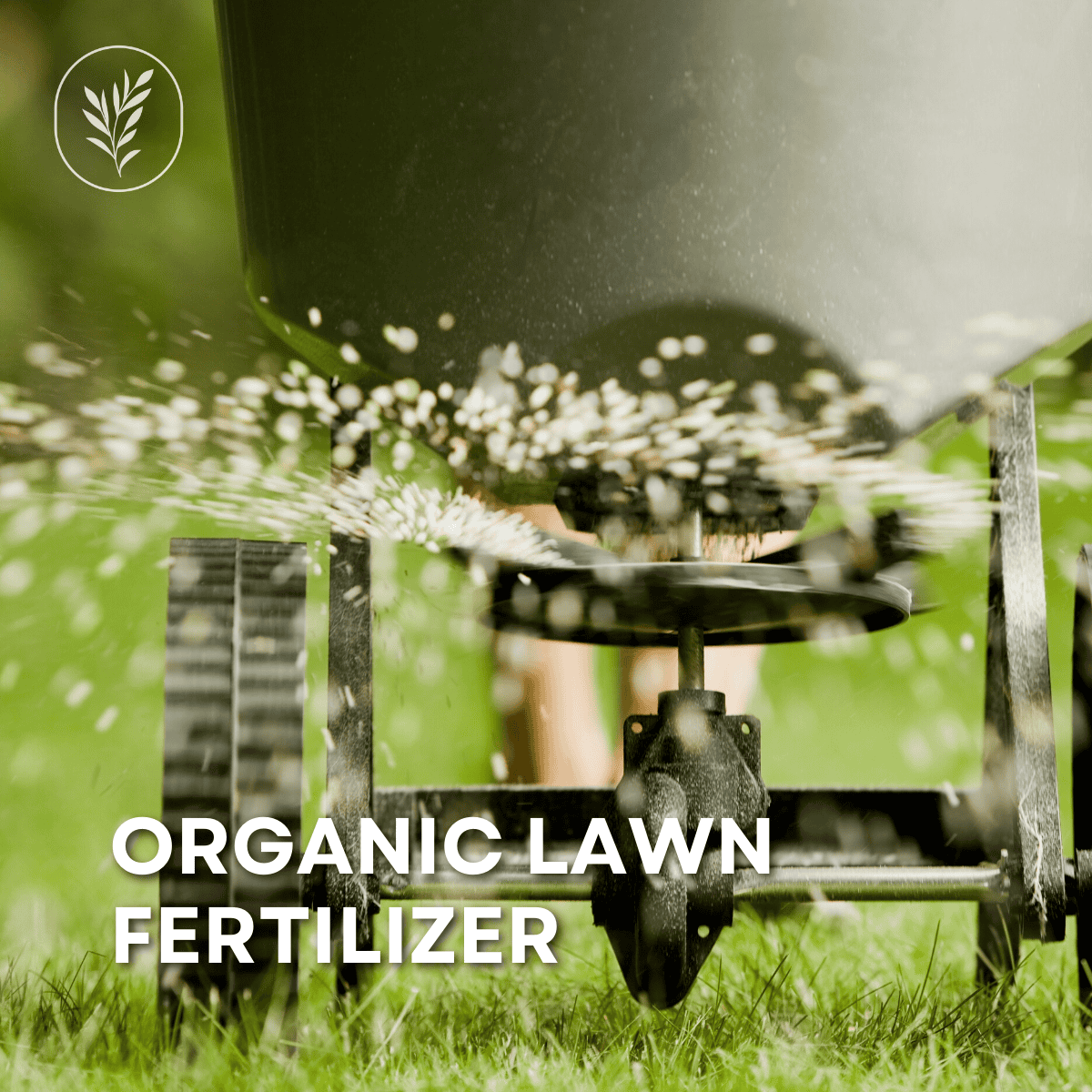Finding the right organic lawn fertilizer is key to growing a lush, green lawn of turf grass. Here’s all about what goes into the best organic lawn fertilizers and how to use these lawn food products effectively.
Here’s how to get the most out of organic lawn fertilizer for your turf grass:
- Choose a nitrogen-rich, low-phosphorus lawn fertilizer that’s sustainably-sourced and safe for organic use.
- Apply the organic lawn fertilizer in the spring with an effective spreader or sprayer (not the one that might come with the fertilizer).
- Supplement the fertilizer application with complementary practices like soil core aeration and top dressing with organic matter.
Read on to learn all about choosing and using organic lawn fertilizer for your home’s lawn.

The basics of organic lawn fertilizer
Organic fertilizer gives your lawn grass a boost of nutrients. Natural lawn food fertilizer products are available online and at local garden centers.
High-quality organic lawn fertilizers are formulated to gently provide the nutrients grass needs. Nutrient nitrogen is perhaps the most important nutrient for lawns and is also a nutrient that lawn soil is likely deficient in. Organic fertilizers provide nitrogen for turf with a low amount of risk both for your lawn and the wider environment.
Organic fertilizers are the natural counterpart to conventional fertilizers. Synthetic fertilizers are manufactured in chemical manufacturing plants and are seen as providing a “quick fix” to green up a lawn. Organic fertilizers generally contain a mixture of naturally-sourced nutrients (instead of synthetic chemicals). Organic products focus on the long-term health of the lawn by providing a steady release of plant nutrients.
Organic fertilizers are safe for the creatures of the soil food web (like earthworms), which are critical for lawn health. Organic fertilizer in combination with natural lawn care practices will help create a low-maintenance, thriving lawn.
Healthy soil free of synthetic chemicals grows robust turf that looks great and requires minimal maintenance. The lawn is sustainable over the long term (and you’ll likely save money on lawn care products over the years).
What are organic lawn fertilizers made of?
Organic lawn fertilizers are made from ingredients derived from natural sources like plants, livestock, or fish. The nitrogen in organic lawn fertilizer is generally derived from poultry feather meal. Many fertilizers also contain seaweed for potassium. A few fertilizers do contain a bit of phosphorus sourced from livestock bone meal.
Nitrogen is consumed by lawn grass in large amounts. It is essential for energy production in the green leaves of plants. Many lawns also have soil that is somewhat deficient in the amounts of nitrogen that grass needs. Because of the need for more nitrogen, organic lawn fertilizers focus mainly on providing added nitrogen to the grass.
How do organic lawn fertilizers work?
Nitrogen in fertilizer can be either quick-release or slow-release. Quick-release nitrogens are immediately available to
Organic lawn fertilizers contain a small amount of quick-release nitrogen, but generally contain a higher percentage of slow-release nitrogen. Quick-release nitrogen must be carefully applied in small amounts or it can actually “burn” lawn grass. Slow-release forms of nitrogen make it possible to apply high-nitrogen grass fertilizer without burning the lawn.
Organic matter is a key part of making slow-release nitrogen available to turfgrass plants. Because organic lawn fertilizer is derived from biodegradable material, it adds to the organic matter of the soil. The organic matter in lawn soil is a food source for beneficial microorganisms that transform nutrients into a form that can be absorbed by plant roots. A lawn will not respond to an application of slow-release fertilizer without the transforming effect from soil microorganisms.
Most organic fertilizers are designed for spring applications. These fertilizers generally have a rather high amount of nitrogen for organic fertilizers. Summer and fall fertilizers are much more likely to focus on adding bulk organic matter to the soil to improve soil structure and support healthy microbes.
What to look for in quality organic lawn fertilizers
Look for the following features when choosing organic lawn fertilizer:
- nitrogen-rich
- low-phosphorus
- sustainably-sourced
- safe for organic use
It’s a rare fertilizer that meets all four characteristics above, but there are a couple available. Think about which features matter most to you. That’ll make it easier to choose from the natural fertilizers listed in the next section!

The best organic fertilizers for grass lawns
So what is the best organic fertilizer for lawn grass? While there is a lot of variety in organic turf formulas, there are certainly some winners. Good lawn food can also be used on other leafy green plants and landscape evergreens.
Here are some of the best natural fertilizers for grass lawns:
- Espoma – Organic All-Season Lawn Food
- Dr. Earth – Organic Nitrogen All-Purpose Fertilizer
- Dr. Earth – Super Natural High-Nitrogen Liquid Lawn Food
- Safer Brand – Lawn Restore
- Safer Brand – Concern All-Natural Weed & Feed
- Scott’s Natural Lawn Food
- Purely Organic Products – Lawn Food Fertilizer
- Purely Organic Products – Liquid Lawn Food
- Down to Earth – Bio-Turf
SoilTech – MiCrop Organic Soil Builder- Fox Farm – Happy Frog Premium Lawn Fertilizer
- Kellogg Garden Organics – Organic Plus Lawn Food
- Milorganite – Slow-Release Nitrogen Fertilizer
- Suståne All Natural Plant Food for Organic Lawns & Landscapes
Here are the key details about each natural lawn food:
Espoma organic all-season lawn food
- NPK = 9-0-0 (7.6% of the nitrogen is slow-release/not water-soluble, and the remaining 0.4% is quick-release/water-soluble)
- Derived from feather meal and poultry manure
- Granulated fertilizer is sold in 14 lb and 28 lb bags
- One 28 lb bag covers up to 5000 square feet (applied with a spreader)
- Best applied in spring, can be applied up to 4 times during the growing season
- Safe for kids, pets & the environment
- Won’t burn lawns or leach out of the soil
- Contains beneficial soil bacteria
- Not currently OMRI-Listed as safe for organic use
Dr. Earth organic nitrogen all-purpose fertilizer
- NPK = 5-0-2 (All 5% of the nitrogen is slow-release/not water-soluble)
- Derived from alfalfa meal, feather meal, and potassium sulfate
- Fertilizer pellets are sold in an 18lb bag
- One 18 lb bag covers 2000 square feet (applied with a spreader)
- Can be applied several times during the growing season
- People & pet safe
- Odor-free formula
- Will not burn plants and grass
- Not currently OMRI-listed as safe for organic use
- Organic Transparency: OIM (Organic Input Materials), CCOF (California Certified Organic Farmers)
Dr. Earth super natural high-nitrogen liquid lawn food
- NPK = 3-0-1 (All 3% of the nitrogen is quick-release/water-soluble)
- Derived from composted grocery produce, grains, seafood, meat, molasses, and even aloe vera.
- Liquid concentrate is sold in a 32 oz bottle with a hose sprayer attachment
- One 32 oz bottle covers up to 5000 square feet (applied with a hose sprayer)
- Can be applied every two weeks
- People & pet safe
- OMRI-listed as safe for organic use
- Organic Transparency; OMRI (Organic Material Review Institute), OIM (Organic Input Materials), CCOF (California Certified Organic Farmers), and NOP (National Organic Program)
Safer brand lawn restore
- NPK = 9-0-2 (8.53% of the nitrogen is slow-release/not water-soluble, and the remaining 0.47% is quick-release/water-soluble)
- Derived from Feather Meal, Soybean Meal, Blood Meal, Alfalfa, Molasses, and Potash
- The formula was changed in the summer of 2019 – some reviewers say the updated product is dustier and stinkier
- Granulated fertilizer is packaged in a 25 lb bag
- One 25 lb bag will cover 6,250 square feet (applied with a spreader)
- Can be applied every 8 weeks
- Non-burning formula
- Safe for children and pets
- Not currently OMRI-listed as safe for organic use
Safer brand concerns all-natural weed & feed
- NPK = 8-2-4 (All 8% of the nitrogen is slow-release/not water-soluble)
- Derived from Corn Gluten Meal, Bone Meal, Potassium Sulfate, and Wheat
- Fertilizer pellets are sold in a 25 lb bag
- One 25 lb bag covers 1500 square feet (applied with a spreader)
- Best applied in early spring before weed seeds germinate
- Safe for children and pets
- Prevents weed seeds from growing while fertilizing existing turf grass plants
- Will not burn the lawn
- Not currently OMRI-listed as safe for organic use
Scott’s natural lawn food
- NPK = 11-2-2 (10% of the nitrogen is slow-release/not
water soluble , and the remaining 1% is quick-release/water soluble ) - Derived from Feather Meal, Meat Meal, Bone Meal, Blood Meal, and Potash
- Granular fertilizer is packaged in 18 lb and 29 lb bags
- One 18 lb bag covers 2500 square feet (applied with a spreader)
- Can be applied every 6-8 weeks, recommended to be used a total of 4 times per year
- Can be used around kids and pets
- Currently OMRI-listed as safe for organic use
Purely organic products lawn food fertilizer
- NPK = 10-0-2 (7.1% of the nitrogen is slow-release/not
water soluble , and the remaining 2.9% is quick-release/water soluble ) - Derived from Soybean Meal, Lysine Amino Acids, Dried Grain from Distillers
- Granular fertilizer is packaged in a 25 lb bag
- One 25 lb bag covers up to 5000 square feet (applied with a spreader)
- Recommended to be applied 4 times a year
- Will not burn the
lawn - Low
odour Family-friendly - Not currently OMRI-listed as safe for organic use
Purely organic products liquid lawn food
- NPK = 13-0-4
- Derived from
Plant-Based Proteins from Food Waste - Liquid concentrate is packaged in a 32 oz bottle
- One 32-ounce bottle covers up to 6, 000 square feet (applied with a hose sprayer)
- Will not burn the
lawn - No manure = no odor
- Family Friendly
- Not currently OMRI-listed as safe for organic use
Down-to-earth bio-turf
- NPK = 8-3-5 (7.2% of the nitrogen is slow-release/not water-soluble, and the remaining 0.8% is quick-release/water-soluble)
- Derived from Feather Meal, Blood Meal, Meat Meal, Bone Meal, and Langbeinite (a potassium magnesium sulfate mineral)
- Granulated fertilizer is sold in a 6 lb. box, a 25 lb. bag, and a 50 lb. bag
- Applied at a rate of 6-12 lbs per 1,000 square feet (applied with a spreader)
- One 6 lb box will cover a maximum of 1000 square feet
- Can also be used on other leafy green plants
- Currently OMRI-listed as safe for organic use
- CDFA Registered Organic Input Material
SoilTech MiCrop organic soil builder
- Designed to add organic matter to the soil that can pull nitrogen from the existing environment (like green manure)
- Derived from Blue-Green Algae and Kaolin Clay
- Powdered fertilizer is sold in an 8oz (1/2 lb) plastic tub
- Applied at a rate of 1.0-1.4 oz per acre
- Mix with water in a hose-end sprayer or watering can
- One 1/2 lb tub covers 15,000 square feet
- Apply one to four times per year at 30-60 day intervals, any time during the growing season
- Can also combat soil salinity
- Currently OMRI-listed as safe for organic use
- NPK = 8-2-6 (7.2% of the nitrogen is slow-release/not water
– soluble, and the remaining 0.8% is quick-release/water-soluble) - Derived from Feather Meal, Bone Meal, Potash, Bat Guano, Kelp, and Gypsum
- Granulated fertilizer is packaged in a 4 lb re-sealable plastic bag
- One 4 lb bag will cover 150 square feet (applied with a spreader)
- Can be applied up to 4 times per year
- Contains beneficial soil microbes
- Not currently OMRI-listed as safe for organic use
Kellogg garden organics organic plus lawn food
- NPK = 4-4-4 (2.5% of the nitrogen is slow-release/not water-soluble, and the remaining 1.5% is quick-release/water-soluble)
- Derived from Poultry Manure, Feather Meal, and Potash.
- Granular fertilizer is packaged in a 20 lb bag
- One 20 lb bag covers 2500 square feet (applied with a spreader or hand
– tossed) - Apply up to four times per year
- People, Pet, and Planet Safe
- Won’t burn the
lawn - Currently OMRI-listed as safe for organic use
- CDFA Registered Organic Input Material
Milorganite slow-release nitrogen fertilizer
- NPK = 6-4-0 (4% of the nitrogen is slow-release/not water
– soluble, and the remaining 2% is quick-release/water-soluble) - Derived from biosolids = sewage sludge wastewater from Milwaukee with added microbes
- Product was reformulated in 2019 (https://www.milorganite.com/blog/milorganite/32lb_Milorganite_Bag)
- Granular fertilizer is packaged in 5 lb and 32 lb bags
- One 32 lb bag covers 2500 square feet (applied with a spreader)
- Apply up to four times per year
- Non-burning
- Safe for children and pets
- Not OMRI-listed as safe for organic use
Suståne all natural plant food for organic lawns & landscapes
- NPK = 8-2-4 (7.2% of the nitrogen is slow-release/not water-soluble, and the remaining 0.8% is quick-release/water-soluble)
- Derived from Composted Turkey Litter, Feather Meal, and Potash
- Granular fertilizer is packaged in a 5 lb, 20 lb, or 50 lb bag
- One 20 lb bag covers 2000 square feet (applied with a spreader)
- Apply 2 to 4 times per year in early spring, late spring, and autumn
- Safe for Plants, People, and the Environment
- Contains naturally occurring beneficial bacteria and fungi
- Currently OMRI-listed as safe for organic use

How to apply organic lawn fertilizer
Applying lawn fertilizer is a process with a few steps. A great first step is to get a soil test done in a proper laboratory. Once you know which nutrients are deficient, it’ll be much easier to choose the perfect organic fertilizer for your unique lawn and yard.
Before applying the fertilizer, consider the following prep steps:
- Mow the lawn
- Pull up weeds
- Remove thatch
- Core aerate
These steps will help maximize the value of your organic lawn fertilizer.
Getting A Soil Test Before Applying Natural Lawn Food
A soil test will determine the amount of organic matter that is currently in your soil. A supply of fresh organic matter in the form of organic lawn fertilizer will keep microbe populations high and healthy. Organic fertilizers must have the microbial activity necessary to release nutrients into the soil.
Get your lawn soil tested by a local laboratory. Call your local extension office (or ask at the nursery) for recommendations if you’re not sure which labs do nutrient and organic matter soil tests. You’ll send off a few cups of your soil to the lab and then receive the results of the soil analysis.
Applying organic lawn fertilizer to turf grass
Most organic lawn fertilizers are sold in granulated or liquid form. Granulated fertilizers are applied with a drop or broadcast spreader. Liquid concentrates are applied with a sprayer.
Granular formulas are generally easier to measure and distribute evenly than liquid formulas. It’s generally a good idea to invest in a dedicated spreader or sprayer rather than using the one that comes with the fertilizer. The provided hose sprayers for liquid fertilizers are especially bothersome, making it VERY worth it to get your own sprayer.
The sprayers that come on top of liquid fertilizer bottles can be a bit of a pain to use. If you must use the provided sprayer, be sure to shake well first. Use the liquid when
Apply the fertilizer according to the instructions from the manufacturer. Most recommend a grid pattern of application (be sure to overlap the passes a little bit). Water the grass thoroughly after applying granulated fertilizer. It’s best to keep the grass moist (but not saturated) for a few days following fertilizer application.
When to apply an organic fertilizer to a lawn
When should I apply an organic fertilizer to my lawn? Organic fertilizer should be applied to the lawn in early spring. Most organic fertilizers can also be re-applied every couple of months throughout the growing season for a total of four fertilizer applications.
It’s best to apply lawn fertilizer when it’s not too hot, but also not terribly rainy. It’s nice to have a few dry days after application.
Newly seeded lawns shouldn’t be fertilized. Give them six weeks to germinate and sprout before applying organic turf fertilizer to new lawns.
Try to use newly-manufactured natural lawn food. It’s generally best to use it within 2 years of the manufacturing date. Follow the instructions on the packaging of the product you choose.
Supplementary lawn care after fertilizing
Supplement the fertilizer application with complimentary lawn care practices like soil core aeration and top dressing with organic matter. Core aeration adds helpful air voids to the soil structure. Topdressing with organic matter enriches the soil.
Both core aeration and topdressing with organic matter are lawn care tasks that support soil flora. These lawn soil microorganisms break down the organic matter into nutrients that can be used by turfgrass. Aeration and topdressing can be done any time throughout the growing season, but it seems like autumn is an excellent time for these tasks. I like to use an organic fertilizer product in the spring, and then follow up with a top-dressing of compost in the fall.
Benefits of Adding Organic Matter (Like Compost)
- Increases the soil’s ability to retain nutrients for the turf grass plants
- Increases the soil’s ability to hold the right amount of water and air for plant roots
- Encourages creatures in the soil-food web, such as earthworms
- Supports beneficial microbes and fungi like mycorrhiza
- Balance pH of the lawn soil
Organic matter in the soil creates higher-quality turf grass. Be sure to use good organic compost. I like homemade compost but have also had good success with store-bought bulk compost made entirely from composted plants. Composted steer manure has also worked.
It’s also time to come to grips with the realization that it’s not reasonable to expect a perfect, weed-free lawn without a significant time investment. A lawn addicted to synthetic chemical fertilizers will not look great after going cold-turkey on manufactured chemicals. It’s not even going to look great after a growing season of organic lawn care. Have patience! The grass will crowd out weeds as it gets healthier over time.
Mow the lawn to about 3″ high throughout the growing season. Try to mow often enough so that the mower is never cutting off more than 1/3 of the height of the blade of grass. Use a mulching mower that returns small grass clippings to the soil. When you water the lawn, water it deeply (place a container on the lawn under the sprinkler to
Organic lawn fertilizer vs. Conventional synthetic fertilizer
Organic lawn fertilizer is the natural counterpart to synthetic turf grass fertilizer. Both can give you a green lawn. But is organic lawn fertilizer better than conventional synthetic fertilizer? I use organic, but there is a lot of debate on which is “better”!
A synthetic fertilizer will green up a lawn in a matter of days, while organic lawn fertilizers take longer. Over the long term, however, the lawn fertilized with organic fertilizer will likely experience better overall soil health and potentially look better too.
Synthetic fertilizers are generally manufactured in chemical plants from petroleum feedstock. These fertilizers are generally cheaper and faster-acting than organic choices. Synthetic fertilizers often have high NPK ratios, making the customer feel like they’re getting more “bang for their buck”. They can, however, harm the soil health of your lawn and even pollute the greater environment.
Organic fertilizers can cost more at the store, but often require fewer applications than synthetic fertilizers as they last longer. The cost can balance out over time. The NPK percentage content values of organic fertilizer may be lower than synthetic, but that’s not necessarily a bad thing. While not a quick fix, organic fertilizers are the best choice for a long-lasting healthy lawn.
Unlike conventional fertilizers, which deliver a heavy, instant dose of synthetic nitrogen (as well as phosphorous and potassium) for your lawn to binge on, organics provide an easier-to-handle diet of nutrients that are released more slowly.
Organic fertilizers have a lower percentage of quick-release nitrogen content than synthetic fertilizers. That can be a good thing or a bad thing depending upon your opinion.
Benefits of organic lawn fertilizer
- Many actually have higher percentages of slow-release nitrogen than synthetic
- Over-fertilizing is much less likely than with synthetic
- Less risky for your lawn and the overall ecosystem
- Includes micronutrients in addition to NPK
- Generally labeled as safe for children and pets
- Often contains beneficial microbes and fungi like mycorrhiza
Over-fertilizing with organic fertilizer
Can you over-fertilize your lawn with organic fertilizer? Organic lawn fertilizer can be over-applied just as over-fertilizing can occur with synthetic products. Chemical nutrients are chemicals, whether they were derived from petroleum feedstock or from ground-up poultry feathers. Still, the health risks to both your lawn and the surrounding ecosystem are lower with organic fertilizers due to the lower nutrient contents and slow-release forms of the nutrients.
The consequences of over-application are generally worse for synthetic fertilizers than for organic fertilizers. Over-applying a synthetic lawn can lead to burnt patches of grass and the eutrophication of nearby waterways. Over-applying organic fertilizer rarely burns and is much less likely to pollute ground and surface water in the local environment. The consequences of over-applying organic fertilizer are more likely to be limited to the cost of excess fertilizer.
Is there a safe lawn fertilizer?
Is there a safe lawn fertilizer? While generally safer than synthetic options, even organic fertilizers have inherent hazards. ALWAYS follow the manufacturer’s directions to ensure you’re safe using the lawn fertilizer product you’ve chosen.
Many fertilizers include warnings like these examples:
- Avoid contact with skin, eyes,
and clothing. - Do not inhale or ingest.
- Store away from heat, out of reach of children.
- Do not contaminate water, food or feed by storage or disposal.
- Do not reuse the container.
Some fertilizers have special instructions for wearing a dust mask, respirator, and/or nitrile gloves during handling. Read and follow the instructions on any product you buy. If you can’t read them on the package, visit the manufacturer’s website to look up the safety data for the product.
Also, note that even organic fertilizers could potentially add high amounts of nutrients to watersheds and lead to the eutrophication of waterways. Here are some common example guidelines for applying lawn fertilizer responsibly:
- Apply only to actively growing turf.
- Do not let excess fertilizer or runoff water enter storm drains or drainage ditches.
- Do not apply if heavy rain is in the forecast.
- Sweep any fertilizer that ends up on paths, driveways, and sidewalks back onto the lawn so it doesn’t enter stormwater systems.
- Check with your local authorities, as some regions have specific regulations for applying lawn fertilizer (even organic fertilizers). This includes prohibited application dates and prohibited nutrients (often phosphorus).
Use only what your lawn needs. Get a soil test before fertilizing the lawn!









